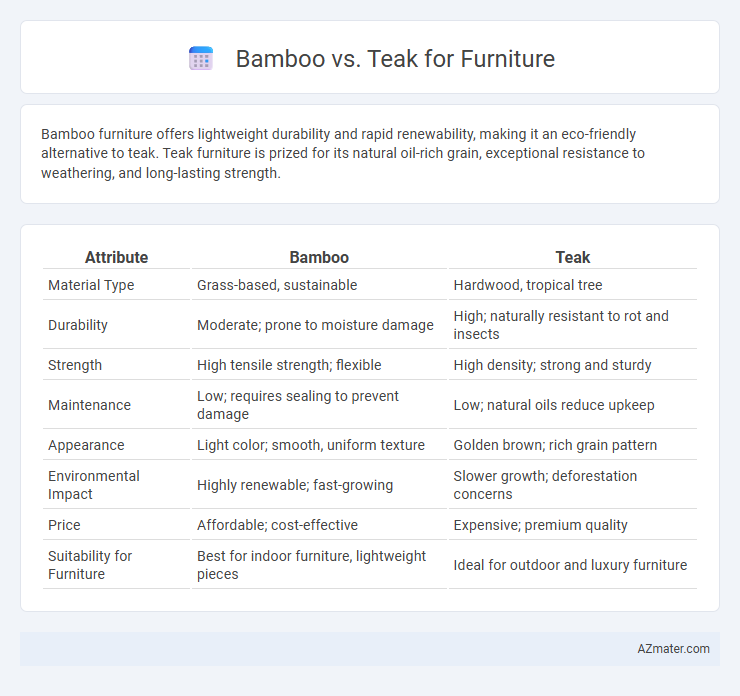Bamboo furniture offers lightweight durability and rapid renewability, making it an eco-friendly alternative to teak. Teak furniture is prized for its natural oil-rich grain, exceptional resistance to weathering, and long-lasting strength.
Table of Comparison
| Attribute | Bamboo | Teak |
|---|---|---|
| Material Type | Grass-based, sustainable | Hardwood, tropical tree |
| Durability | Moderate; prone to moisture damage | High; naturally resistant to rot and insects |
| Strength | High tensile strength; flexible | High density; strong and sturdy |
| Maintenance | Low; requires sealing to prevent damage | Low; natural oils reduce upkeep |
| Appearance | Light color; smooth, uniform texture | Golden brown; rich grain pattern |
| Environmental Impact | Highly renewable; fast-growing | Slower growth; deforestation concerns |
| Price | Affordable; cost-effective | Expensive; premium quality |
| Suitability for Furniture | Best for indoor furniture, lightweight pieces | Ideal for outdoor and luxury furniture |
Introduction to Bamboo and Teak Furniture
Bamboo furniture is renowned for its rapid renewability, lightweight structure, and natural resistance to moisture and pests, making it an eco-friendly choice for sustainable interiors. Teak furniture, prized for its dense hardwood and high oil content, offers exceptional durability, weather resistance, and a rich golden-brown finish that ages beautifully over time. Both bamboo and teak provide unique advantages for furniture construction, with bamboo excelling in renewability and flexibility, while teak is unmatched for longevity and classic elegance.
Sustainability: Bamboo vs Teak
Bamboo is a highly sustainable material due to its rapid growth rate, reaching maturity in just 3-5 years, and its ability to regenerate without replanting, making it an eco-friendly option for furniture production. In contrast, teak trees take approximately 20-25 years to mature, leading to slower replenishment rates and greater environmental impact when harvested unsustainably. Bamboo furniture typically has a lower carbon footprint and requires less water and pesticides than teak, supporting more sustainable forestry practices and reducing deforestation.
Durability and Strength Comparison
Bamboo furniture offers remarkable strength with a tensile strength comparable to steel, making it highly durable and resistant to cracking under pressure. Teak wood boasts exceptional durability due to its high oil content, natural resistance to moisture, insects, and decay, ensuring long-lasting furniture ideal for outdoor use. While teak excels in weather resistance and aging gracefully over time, bamboo's rapid renewability and flexibility make it a sustainable yet robust alternative for durable furniture construction.
Aesthetics and Design Versatility
Bamboo furniture offers a sleek, modern aesthetic with a light, natural color that complements minimalist and contemporary designs, while teak provides a rich, warm tone with intricate grain patterns ideal for classic and rustic styles. The flexibility of bamboo allows for innovative shapes and lightweight structures, enhancing design versatility in eco-friendly and casual settings. Teak's dense, durable wood supports intricate carvings and robust furniture designs, making it a preferred choice for traditional, high-end indoor and outdoor pieces.
Maintenance and Care Requirements
Bamboo furniture requires regular cleaning with a damp cloth and occasional application of non-toxic sealants to maintain its moisture resistance and prevent mold growth. Teak furniture, known for its natural oil content, demands less frequent maintenance but benefits from periodic oil treatments to preserve its rich color and prevent cracking. Both materials require protection from prolonged exposure to harsh weather conditions to extend their lifespan and maintain aesthetic appeal.
Cost Differences: Bamboo vs Teak
Bamboo furniture is generally more cost-effective than teak due to its rapid growth cycle and abundant availability, making it an affordable option for budget-conscious buyers. Teak, known for its durability and rich grain, commands a higher price owing to its slower growth rate and the labor-intensive harvesting process. The price disparity often reflects teak's superior resistance to weather and pests, justifying its premium in long-term investment furniture.
Weather Resistance and Outdoor Use
Bamboo is highly weather-resistant due to its natural silica content, making it an excellent choice for outdoor furniture as it withstands moisture and temperature fluctuations without warping or cracking. Teak contains natural oils that provide superior resistance to water, insects, and decay, allowing outdoor furniture to maintain durability and appearance over many years, even in harsh weather conditions. Both materials offer exceptional performance for outdoor use, with teak generally providing a longer lifespan and bamboo offering a more sustainable, eco-friendly option.
Eco-Friendly Factors and Environmental Impact
Bamboo furniture stands out for its rapid renewability, as bamboo grows up to 3 feet per day and reaches maturity within 3 to 5 years, significantly reducing deforestation compared to teak, which takes 20 to 25 years to mature. Bamboo's carbon sequestration capacity is higher, absorbing more CO2 per acre annually, thereby contributing more effectively to climate change mitigation than teak. The harvesting of bamboo typically causes less soil erosion and biodiversity loss, making it a more environmentally sustainable choice for eco-conscious furniture production.
Best Uses: Indoor and Outdoor Applications
Bamboo's lightweight, moisture-resistant properties make it ideal for indoor furniture like chairs and tables, as well as outdoor items such as garden benches and patio sets. Teak's dense, oily grain provides exceptional durability and natural resistance to weather, making it perfect for high-end outdoor furniture including decks, poolside loungers, and dining sets. Both materials excel in sustainability, with bamboo offering rapid renewability and teak prized for longevity in harsh outdoor environments.
Conclusion: Choosing the Right Wood for Your Furniture
Bamboo offers sustainability, rapid growth, and natural moisture resistance, making it an eco-friendly choice for modern furniture. Teak provides exceptional durability, rich grain, and natural oils that resist decay and insects, ideal for high-end, long-lasting pieces. Selecting the right wood depends on balancing environmental impact, budget, and desired furniture lifespan.

Infographic: Bamboo vs Teak for Furniture
 azmater.com
azmater.com